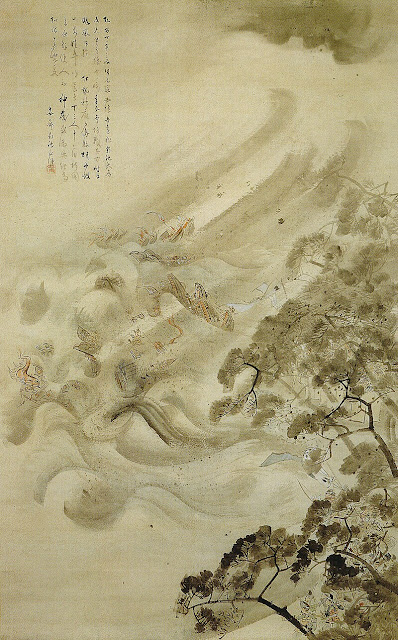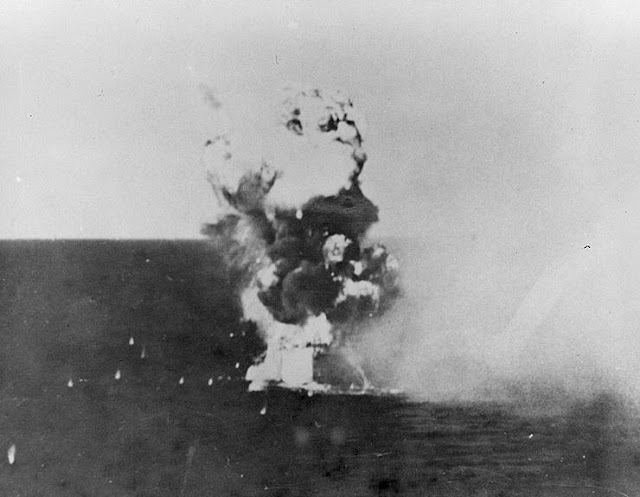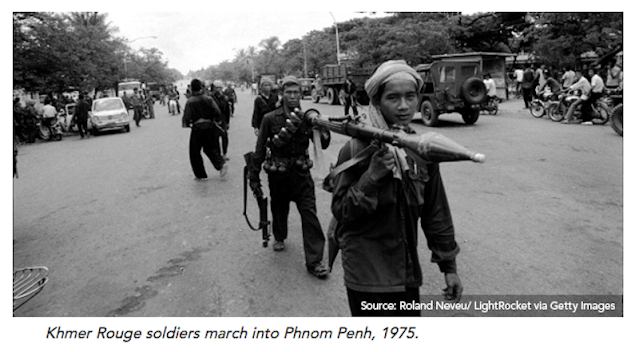On January 5, 1945, Japanese pilots received the first order to become kamikaze, meaning “divine wind” in Japanese. The suicidal blitz of the kamikazes revealed Japan’s desperation in the final months of World War II. Most of Japan’s top pilots were dead, but youngsters needed little training to take planes full of explosives and crash them into ships. At Okinawa, they sank 30 ships and killed almost 5,000 Americans.
2. USS Bunker Hill (CV-17), an aircraft carrier, was hit by two kamikazes on 11 May 1945, resulting in 389 personnel dead or missing and 264 wounded.
3. Lt. Yoshinori Yamaguchi's Yokosuka D4Y3 (Type 33 Suisei) "Judy" in a suicide dive against USS Essex on 25 November 1944. The attack left 15 killed and 44 wounded. The dive brakes are extended and the non-self-sealing port wing tank trails fuel vapor and/or smoke.
4. A kamikaze aircraft explodes after crashing into Essex's (CV-9) flight deck amidships 25 November 1944.
6. Remains of en:Yokosuka D4Y "Suisei" aircraft tail section (starboard elevator unit) aboard USS Kitkun Bay (CVE 71) after Kamikaze attack. The Judy made a run on the ship approaching from dead astern, it was met by effective fire and the plane passed over the island and exploded. Parts of the plane and the pilot were scattered over the flight deck and the forecastle.
7a / 7b. A Japanese Kamikaze aircraft diving on the U.S. Navy light cruiser USS Columbia (CL-56) at 1729 hrs on 6 January 1945, during the Lingayen Gulf operation. This plane hit the main deck by the after gun turret, causing extensive damage and casualties. The plane and its bomb penetrated two decks before exploding, killing 13 and wounding 44.
8. An A6M Zero (A6M2 Model 21) towards the end of its run at the escort carrier USS White Plains (CVE-66) on 25 October 1944. The aircraft missed the flight deck and impacted the water just off the port quarter of the ship, scattering debris across the deck.
9. An A6M5 "Zero" diving towards American ships in the Philippines in early 1945.
10. USS Louisville (CA-28) is struck by a Mitsubishi Ki-51 kamikaze at the Battle of Lingayen Gulf, 6 January 1945.
11. Kamikaze attack on the USS Missouri (BB-63). About to be hit by a Japanese A6M "Zero" kamikaze, while operating off Okinawa on 11 April 1945. The plane hit the ship's side below the main deck, causing minor damage and no casualties on board the battleship. A 40 mm quad gun mount's crew is in action in the lower foreground.
12. The aircraft carrier HMS Formidable (R67) on fire after being struck by a Kamikaze off Sakishima Gunto. Formidable was hit at 1130 hrs, the kamikaze making a massive dent about 10 ft. long, 2 ft. wide and deep in the armored flight deck. A large steel splinter speared down through the hangar deck and the centre boiler-room, where it ruptured a steam line, and came to rest in a fuel tank, starting a major fire in the aircraft park. Eight crew members were killed and forty-seven were wounded. One Vought Corsair and ten Grumman Avengers were destroyed.
13. Damage to USS Newcomb (DD-586) caused by the impact of four kamikazes. Newcomb was damaged beyond economical repair and scrapped after the war.
14. Part of the anti-aircraft gun crew of the Battleship New Jersey (BB-62), watching helplessly, as a Japanese kamikaze plane prepares to strike the aircraft carrier Intrepid (CV-11) on 25 November 1944. Over 75 men were killed or missing and 100 wounded.
15a / 15b. Burial at sea for the casualties of the Japanese kamikazi attack on the USS Intrepid (CV-11) in the Philippines - 11.25.1944

16. Aircraft Carrier USS Franklin (CV-13) alongside the USS Belleau Wood (CVL-24) on 10.1944 - Intrepid was hit by kamikaze aircraft near Okinawa. Returned to battle on 3.15.1945
17. HMS Sussex bears the imprint of a kamikaze attack (Mitsubishi Ki-51) - 6.26.1945
18. Japanese Kamikazi headed down after being hit by anti-aircraft fire from the USS Hornet (CV-8) 1945
19. The USS Suwannee (AVC-27), under attack by a Zero of the Yamato-tai as she recovered torpedo bombers. The damage was not severe but the Suwannee had to be detached from the force to go back to the US for repairs. 26 Oct., 1944
20. Chiran high school girls are waving farewell with cherry blossom branches to a taking-off kamikaze pilot. The aircraft, an Army Type 1 fighter "Hayabusa" III- type-Ko holding a 250kg bomb, is departing towards Okinawa on April 12, 1945.
21. Japanese Yokosuka MXY-7 Ohka ("cherry blossom"), a specially built rocket-powered kamikaze aircraft used towards the end of the war. The U.S. called them Baka Bombs ("idiot bombs"). Currently in the Museum of Science and Industry in Manchester.
On January 5, 1976, Khmer Rouge leader Pol Pot announces a new constitution changing the name of Cambodia to Kampuchea and legalizing its Communist government. During the next three years his brutal regime sent the nation back to the Middle Ages and was responsible for the deaths of an estimated 1 to 2 million Cambodians.
Pol Pot, who was born Saloth Sar in 1925 to a relatively well-off Cambodian family, became involved in the Communist movement as a young man studying in Paris. After he returned home to Cambodia, which gained its independence from France in 1954, he rose through the ranks of his homeland’s small, underground Communist Party. Influenced by China’s Mao Zedong, by the mid-1960s, Pol Pot, also known as Brother Number One, was heading up Cambodia’s Communist movement and living in a remote part of the country with a band of supporters.
Cambodia’s ruler, Prince Norodom Sihanouk, was overthrown in a pro-American coup in 1970 and the Khmer Rouge, with initial help from Vietnamese Communists, then waged a civil war against the new government of Lon Nol. At the same time, the U.S. launched a bombing campaign and sent in soldiers to Cambodia to hunt down North Vietnamese Communist troops operating there.
In April 1975, following five years of fighting, Pol Pot’s guerillas seized power in the Cambodian capitol of Phnom Pehn. Exhausted by years of conflict, many of the city’s 2 million residents initially welcomed the Khmer Rouge as liberators who would bring about a social revolution. Instead, Pol Pot’s inept attempt at building a peasant-based agrarian utopia became a nightmarish reign of terror and genocide. Cambodians were forced into the countryside to work in communes, anyone with education or wealth was killed and schools, newspapers, hospitals, culture, religion and private property were abolished. Tens of thousands of Cambodians died of starvation while countless others succumbed to disease and forced labor or were murdered.
In December 1978, following clashes over territory, Vietnam invaded Cambodia. Pol Pot fled to Thailand and spent almost two decades hiding out in jungle camps there and in northern Cambodia, protected by guerillas and the Thai military. In 1997, following an internal power struggle, Pol Pot was arrested by members of his own party on charges of treason. He died of natural causes on April 15, 1998, without ever having to face justice for his crimes.
Pol Pot
Pol Pot on his unceremonial deathbed































No comments:
Post a Comment